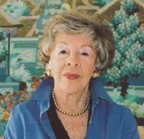
 Judy Cassab endured a series of confronting challenges throughout her life to become one of the most respected artists of her time. Her work is strong, resilient and vibrant, like the woman herself.
Judy Cassab endured a series of confronting challenges throughout her life to become one of the most respected artists of her time. Her work is strong, resilient and vibrant, like the woman herself.
Born in Vienna, Austria, in 1920, she studied at the Academy of Art in Prague. In 1939, she married Jansci Kampfner who was later interned in Nazi forced-labour camps. Her family were all killed in Auschwitz. After her husband’s return, a son, John, was born in 1945. A second son followed in 1947 and in 1950 the family, in an endeavour to leave their fraught past behind, migrated to Sydney.
But memories of the war and the Holocaust refused to fade and life was not easy. She had a loving but stormy marriage and found it difficult to mix being an artist, wife and mother. Judy was a female artist in a foreign landscape at a time when women as artists were not taken seriously by their peers. She suffered breakdowns, but fought back and went on to forge a life for herself and her family.
Because of this, her style is instantly recognisable. She is celebrated for her haunting, desert landscapes as well as her wonderful portraits.
Since the early 1950s, Judy Cassab has held more than 70 solo and group exhibitions in Australia and overseas, travelled and painted nationally and internationally, and has work held in major collections in Australia, Britain and Europe
Recognition came in 1960, when Judy Cassab won the Archibald Prize, winning it again seven years later. She was awarded the Commander of the Order British Empire in 1969 and the Order of Australia in 1988 for her contribution to art, confirming that the journey was worth it.
Copyright © 2007 Abstract Australis. All rights reserved. Click here to view copyright statement